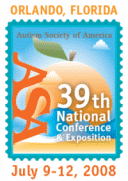 |
The ASA's 39th National Conference on Autism Spectrum Disorders of ASAThe Westin Kierland Resort & Spa, Scottsdale, AZ |
| For a complete author index with session numbers, please click here | |
| Friday, July 11, 2008: 10:45 AM-12:00 PM | |||
| Sun Ballroom B | |||
| #3613- Oxidative Stress & Autism: A Roadmap for Effective Treatment | |||
| This workshop will cover Pfeiffer Treatment Center's effective biomedical approaches involving prescribed and individualized nutrient therapy - vitamins, minerals, and amino acids - to treat the person's system to help direct treatment. Past and new research findings of Health Research Institute (the reseach and development arm of the organization) will also be discussed including the effects of oxidative stress and low metallothionein activity in ASD. | |||
| Presenter: | |||
|
| |||
|
Recent research has shown that oxidative stress is a dominant factor in autism-spectrum disorders (ASD). There are many different genetic defects that can predispose a child to ASD by weakened protection against oxidative stress, rendering the brain vulnerable to toxic metals., viruses and other environmental insults. The net result can be destruction of brain cells, incomplete maturation of the brain, and onset of autism. The harmful effects of oxidative stress on brain development, methylation, sulfur chemistry, the G.I., tract, protein digestion, and immune function will be discussed. In 2000, Health Research Institute (HRI) and Pfeiffer Treatment Center (PTC) in New research findings at PTC include (a) increased oxidative damage to vascular tissue; (b) depressed metallothionein in red blood cells, and (c) abnormal hormone chemistry. In collaboration with the U.S. Department of Energy Argonne National Laboratory and the |
|||
See more of General Submissions
See more of The ASA's 39th National Conference on Autism Spectrum Disorders